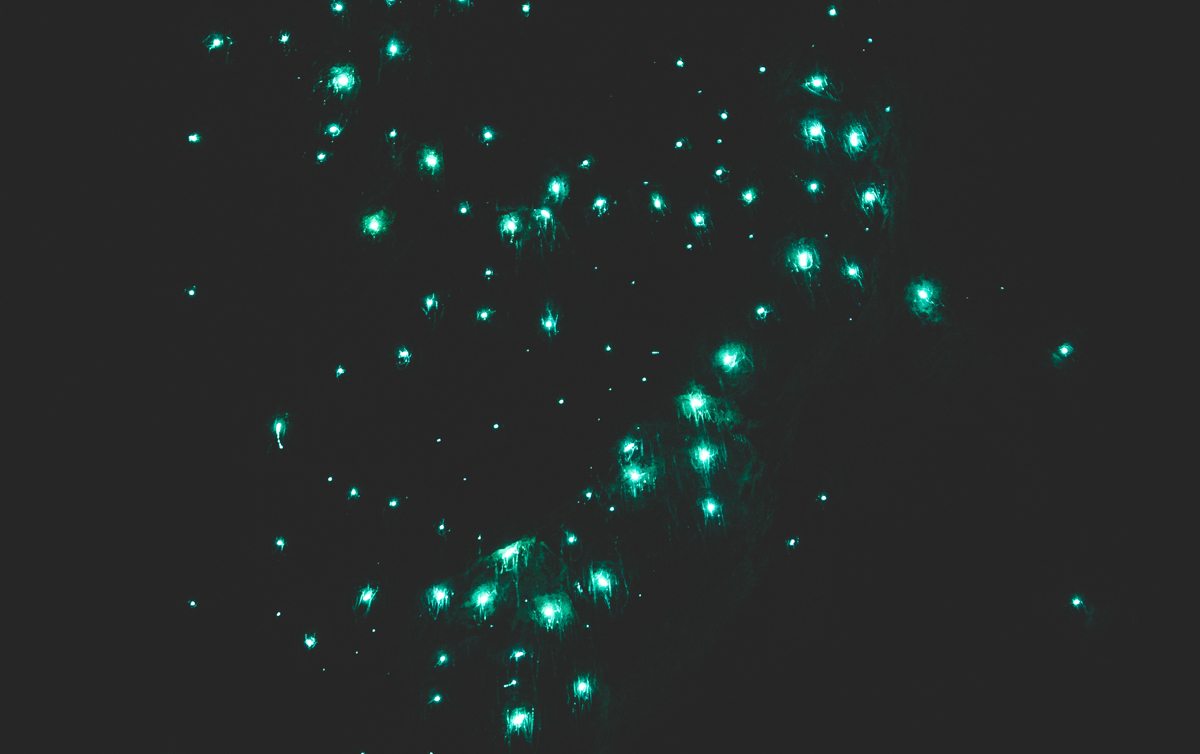Seeing glowworms was very high up on my to do list this year when I spent the austral summer months in New Zealand and Australia travelling around in a campervan. I loved the idea of standing inside a dark cave and being surrounded by hundreds of tiny, living stars, shining down on me.
In the Americas and Europe, glowworms and fireflies are the common names for a bunch of beetle species (in the Lampyridae family), but in New Zealand and Australia glowworms are the larvae stage of a small group of insects called fungus gnats. One group of these fungus gnats, all in the genus Arachnocampa, are only found in New Zealand and Australia and these were the little guys that we were hoping to see.
Most fungus gnats eat fungus (duh), but some of them are predators in their larval stage. These predatory gnats are in their larval stage are called glowworms and use bioluminescence to lure their prey into silky threads – like a freaky spider/anglerfish fusion.

From a quick Google search it was pretty clear that glowworms had become a serious tourist trap in New Zealand. Tours of glowworm caves were costing as much as €50 and photography was banned because they couldn’t trust the vast numbers of tourists to all know how to turn the flash off on their phones.
Glowworms are found in thousands of caves and grottos all over New Zealand and it was surprisingly easy to find places to see them where we could avoid the crowds and entrance fees.
Our glowworm experiences
Waipu caves just south of Whangarei and the Ruakuri Walk in Waitomo are two fantastic places in New Zealand to enjoy glowworms without having to be shepherded around in a massive herd of tourists.
Our best glowworm experience was along the Ruakuri Bush Walk, which is a phenomenal walk even without the little living stars. We parked our van at the trailhead about an hour before sunset and explored the area for the evening. The trail is fantastic, full of brilliant caves and bridges all in a lush, diverse forest.


I found that the best time to photograph the glowworms was about 45 minutes after sunset when there was the perfect balance of light; the afterglow from the sunset was just bright enough to light up to scene but dark enough to let the glowworms shine. It was a really special moment, staring up at the glowworms with our faces illuminated by the turquoise lights these tiny creatures produced.

A few months later we found ourselves looking at glowworms again. Although these worms were closely related to the ones we had seen in New Zealand they were over 2000km away in Springbrook National Park on Australia’s Gold Coast. We had hiked to a cave system with a gigantic waterfall crashing through the ceiling that has a huge colony of glowworms in it. As we admired these tiny insects hundreds of bats were whizzing around our heads, pretty unforgettable.

Some advice for photographing glowworms
- Never use the flash on your camera (or phone) – this can really harm the little glowworms and can disorientate other animals living in the caves.
- Be careful – don’t go into caves during or after heavy rain and always bring a torch (but shine it on the ground instead of up at the glowworms!)
- Photographing glowworms is very like photographing the night sky. You’ll need a tripod so that you can make long exposures to let as much light onto your camera’s sensor as possible.
